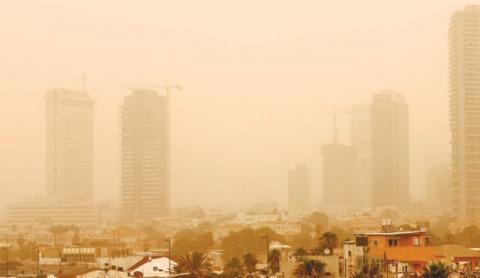Israel expected to approve first national plan to combat air pollution
Research undertaken by the ministry during the past two years forecasts a grim future for breathers in the land of Israel. In another decade, this research predicts, about 800 people a year will die as a result of breathing air that's been polluted by the emission of various compounds during chemical processes. In addition, thousands of people are expected to be hospitalized for short or prolonged periods each year as a result of cardiac-lung diseases that will develop due to exposure to air pollution. These forecasts are likely to come true if serious steps are not taken to reduce air pollution levels, say researchers.
Recent years have seen a reduction of pollution emitted from industrial and energy facilities in Israel. Sulfuric dioxide pollution has decreased by 40 percent since factories and power plants began to use natural gas.
In contrast, transportation-related pollution levels have risen, particularly from vehicles that run on diesel. Experts in the Haifa area report that diesel-powered vehicles constitute just 14.5 percent of the total number of vehicles on the road in the Haifa metropolitan area, but account for two-thirds of nitrogen oxide (one of the main causes of respiratory illnesses ) levels in Haifa.
Environmental Protection Ministry officials note that the use of cleaner, more environmentally-friendly cars is beginning to make a difference. Nitrogen oxide levels have fallen close to 20 percent during the past decade. Still, the ministry is concerned that the heavy use of private cars in Israel will keep nitrogen oxide levels above the desired target in coming years.
One step the plan calls for is to spend NIS 80 million to take old, polluting cars off the roads. Another step is a government investment in public bus service, by creating bus-only traffic lanes, for example.
Yet the plan lacks concrete proposals to overcome many obstacles that impede the development of light railway services and fast bus service in Jerusalem, as well as in the Dan and Sharon regions in the center of the country. These obstacles include funding problems and disagreements between local municipalities regarding bus and railway routes. Attempts to establish rapid bus service connecting Tel Aviv to nearby cities have failed for years. And it seems that a light railway service in the center will only start operating at the end of the decade, and even then, it's not expected to be expansive.
"This plan is actually a step backwards, compared to an earlier program formulated by the Ministry of Environmental Protection, and the scope of financial support for the plan has been scaled back to a quarter of the sum originally proposed," said Dr. Arye Wagner of the IUED's science department.
He cited as an example the removal from the plan of a clause that mandated allocations for public transportation companies, so that they could equip themselves with low-pollutant buses.
"Yes, it is true that our original plan has been scaled down due to budgetary pressures," conceded Shuli Nezer, director of the ministry's Air Quality Department. "But we will still expand activities to reduce air pollution, activities whose economic worthiness have been proven."
Jerusalem gets into clean air act
A key component in the campaign to reduce air pollution levels in Israel involves local councils, which have the ability to influence the development of public transportation initiatives. A local council can also legislate municipal ordinances that, among other things, could require gas stations to offer cleaner fuels. (The Tel Aviv Municipality has enforced such an ordinance in recent years ).
In past years, several major cities have drafted plans to reduce air pollution, in keeping with target figures set by the Ministry of Environmental Protection. Last week, Jerusalem, Israel's largest city, unveiled its plan to reduce air pollution levels.
Jerusalem's new plan proposes the expansion of public transport service in the capital. Among other proposals, it calls for the establishment of a "park-and-ride" parking lot west of Jerusalem, at the Harel exchange. Drivers would park in the lot, and then use public transportation to enter the city. The plan also calls for the establishment of several other such park-and-ride sites, at industrial zones within the city.
The plan's most daring proposal is that a clean air zone be designated in the heart of the city. Polluting vehicles would not be allowed to enter this zone. The region would stretch from a spot west of the Old City, and continue along King George Street.
Under the plan, trucks that are 12 years or older would not be allowed into the zone by the year 2015. This would be enforced by a sophisticated camera system.
Bans or limitations on vehicle traffic in designated urban areas are common today in many European cities, particularly in historic areas. In Israel, only one such initiative has ever been attempted - in Tel Aviv - and the initiative has not been considered successful.
By Zafrir Rinat

